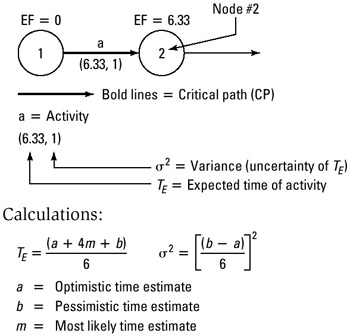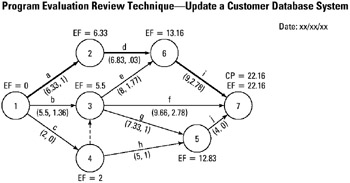Tool 152: Program Evaluation and Review Technique (PERT)
| AKA | PERT/CPM Method, Critical Path Method |
| Classification | Planning/Presenting (PP) |
Tool description
Developed in the 1950s by the U. S. Navy, the PERT network is of extreme importance in project management. It is designed to assist in the planning and controlling of projects and new product development efforts. Drawn as a network with various paths, it displays Critical Path sequence, expected activity time and variance, and overall time to completion.
Typical application
-
To plan, schedule, and control a new program or product development effort.
-
To document and track a complex project.
-
To designate critical path and show other interrelationships.
-
To ensure time and resource management, and to reduce project costs through coordination and communication.
Problem-solving phase
| Select and define problem or opportunity | |
| Identify and analyze causes or potential change | |
| Develop and plan possible solutions or change | |
| → | Implement and evaluate solution or change |
| → | Measure and report solution or change results |
| Recognize and reward team efforts |
Typically used by
| Research/statistics | |
| Creativity/innovation | |
| 2 | Engineering |
| 1 | Project management |
| 4 | Manufacturing |
| Marketing/sales | |
| 5 | Administration/documentation |
| Servicing/support | |
| Customer/quality metrics | |
| 3 | Change management |
before
-
Work Breakdown Structure (WBS)
-
Project Planning Log
-
Process Analysis
-
Milestones Chart
-
Activity analysis
after
-
Responsibility Martix
-
Gantt Chart
-
Resource Histogram
-
Selection Matrix
-
Resource Requirements Matrix
Notes and key points

| Activity | a | m | b | TE | σ2 |
|---|---|---|---|---|---|
| a | 4 | 6 | 10 | 6.33 | 1 |
| b | 3 | 5 | 10 | 5.5 | 1.36 |
| c | 2 | 2 | 2 | 2 | 0 |
| d | 6 | 7 | 7 | 6.83 | .03 |
| e | 4 | 8 | 12 | 8 | 1.77 |
| f | 6 | 9 | 16 | 9.66 | 2.78 |
| g | 5 | 7 | 11 | 7.33 | 1 |
| h | 4 | 4 | 10 | 5 | 1 |
| i | 2 | 10 | 12 | 9 | 2.78 |
| j | 4 | 4 | 4 | 4 | 0 |
Step-by-step procedure
-
STEP 1 Collect data on project activities. See example Update a Customer Database System.
-
STEP 2 Construct a preliminary network, account for all required activities, and calculate expected time (TE) and variance (σ2) for each.
-
STEP 3 Determine and highlight critical path (CP), and calculate early finish (EF) for each node.
-
STEP 4 Check all network linkages and calculations and date the finalized PERT network.
Example of tool application

EAN: 2147483647
Pages: 326